Deep Learning: Methods, Algorithms, Applications and Future Trends
VerifiedAdded on 2023/06/13
|10
|2301
|493
Literature Review
AI Summary
This literature review provides a comprehensive overview of deep learning, a machine learning technique enabling computers to perform human-like tasks. It covers the importance of deep learning, highlighting its high accuracy and applicability to real-world problems. The review discusses various deep learning methods, including deep convolutional neural networks, and key algorithms such as Restricted Boltzmann Machines (RBMs) and Convolutional Neural Networks (CNNs). Current applications in areas like image recognition, face recognition, and image colorization are explored, along with a discussion on the future trends of deep learning, including advancements in data handling, algorithm development, and integration with big data analytics platforms. The review concludes that deep learning holds significant potential for future technological advancements.
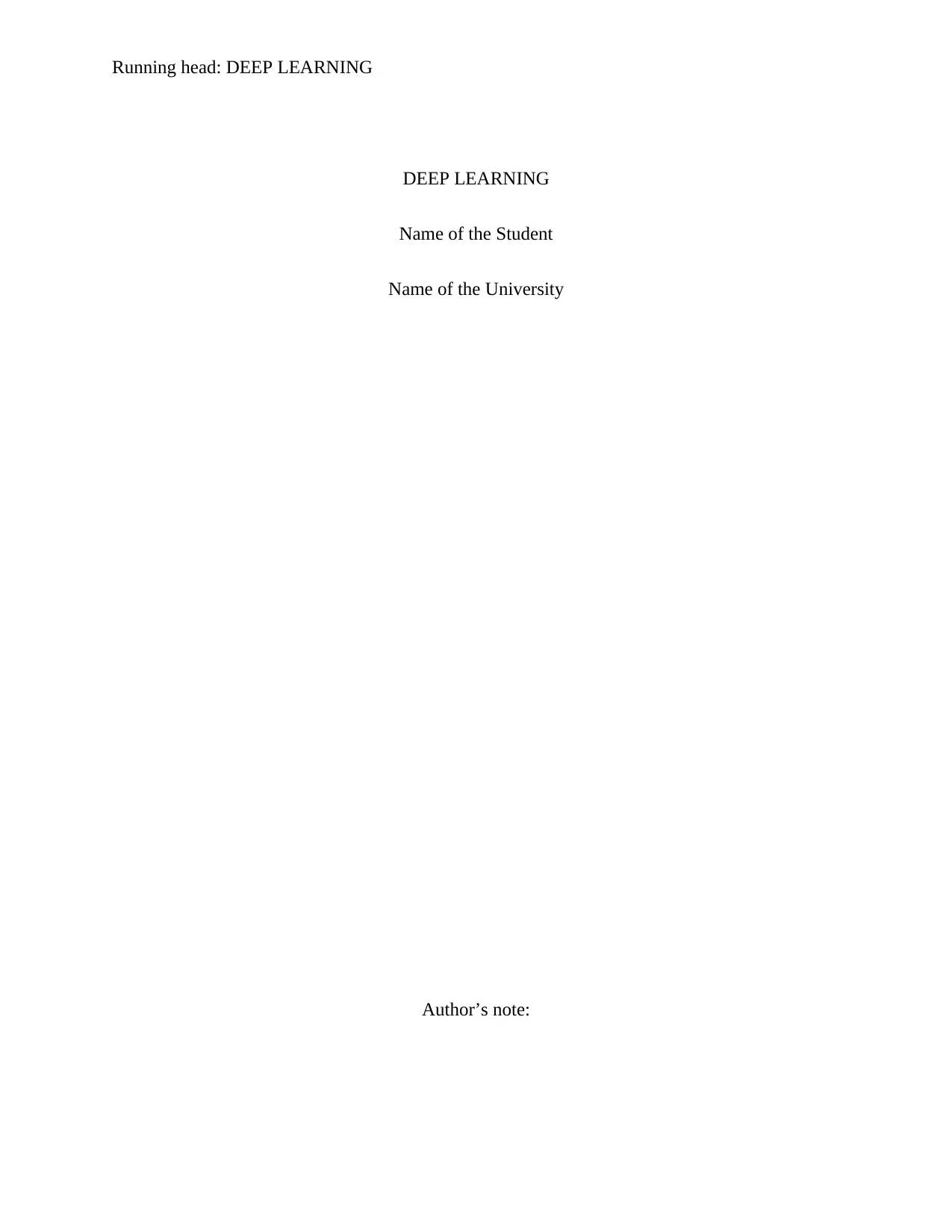
Running head: DEEP LEARNING
DEEP LEARNING
Name of the Student
Name of the University
Author’s note:
DEEP LEARNING
Name of the Student
Name of the University
Author’s note:
Paraphrase This Document
Need a fresh take? Get an instant paraphrase of this document with our AI Paraphraser
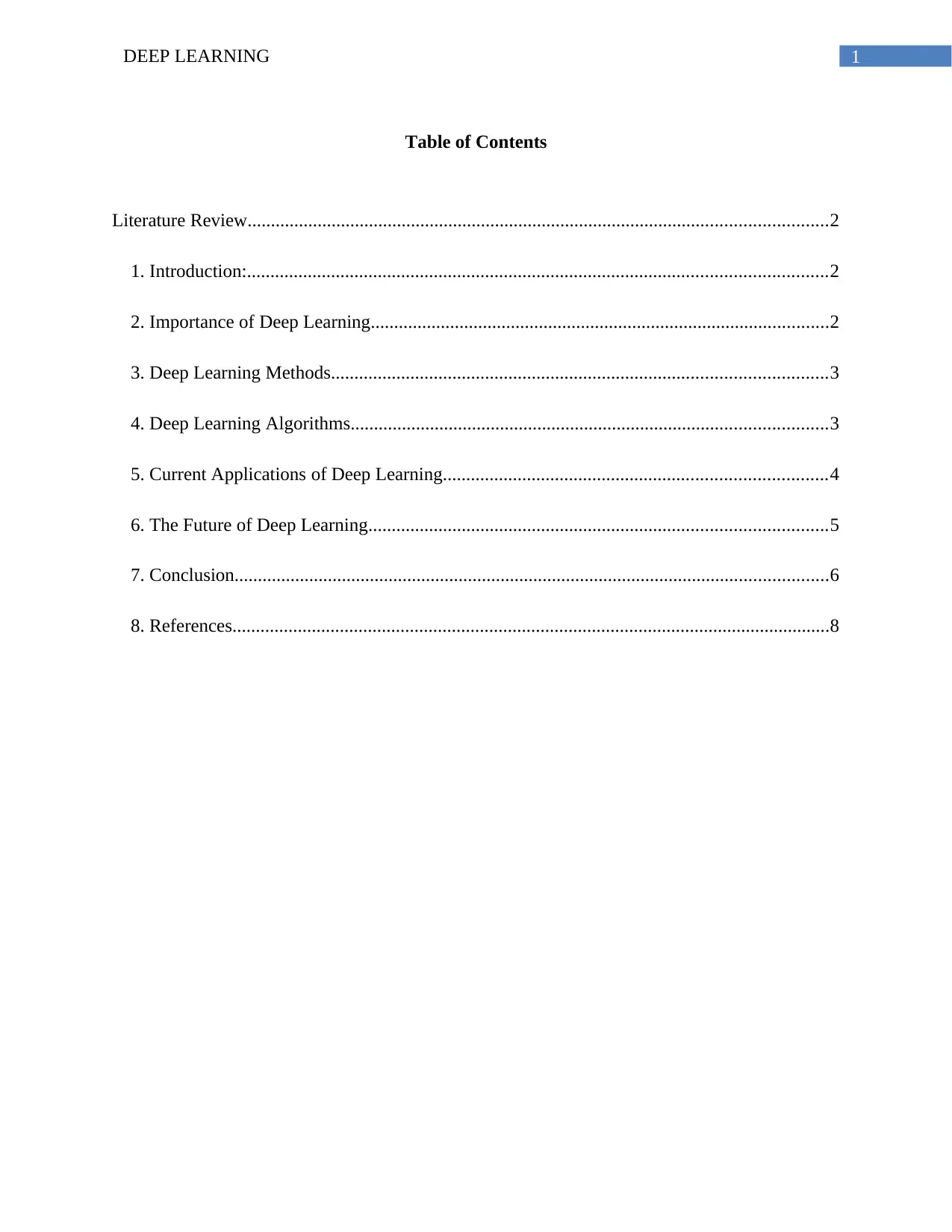
1DEEP LEARNING
Table of Contents
Literature Review............................................................................................................................2
1. Introduction:............................................................................................................................2
2. Importance of Deep Learning..................................................................................................2
3. Deep Learning Methods..........................................................................................................3
4. Deep Learning Algorithms......................................................................................................3
5. Current Applications of Deep Learning..................................................................................4
6. The Future of Deep Learning..................................................................................................5
7. Conclusion...............................................................................................................................6
8. References................................................................................................................................8
Table of Contents
Literature Review............................................................................................................................2
1. Introduction:............................................................................................................................2
2. Importance of Deep Learning..................................................................................................2
3. Deep Learning Methods..........................................................................................................3
4. Deep Learning Algorithms......................................................................................................3
5. Current Applications of Deep Learning..................................................................................4
6. The Future of Deep Learning..................................................................................................5
7. Conclusion...............................................................................................................................6
8. References................................................................................................................................8
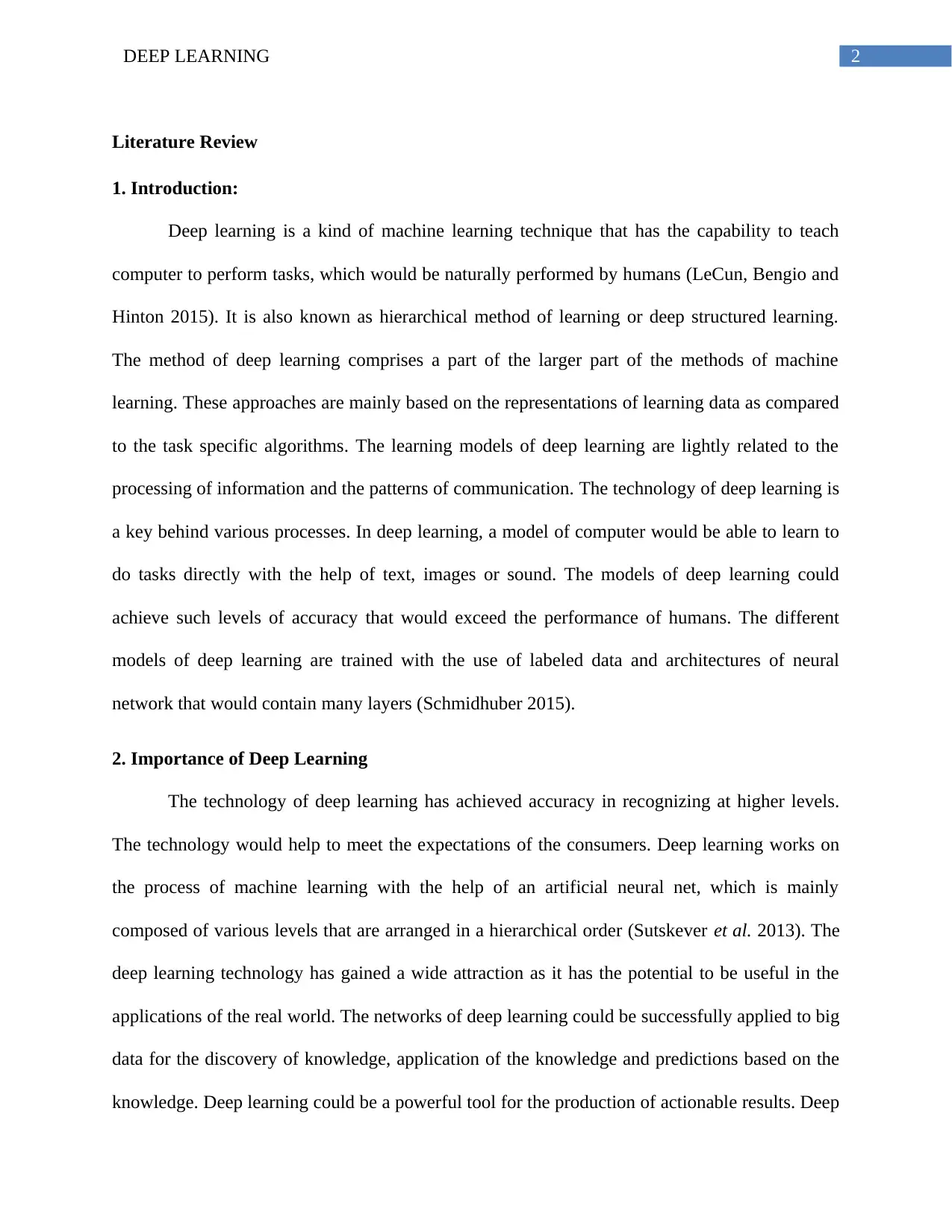
2DEEP LEARNING
Literature Review
1. Introduction:
Deep learning is a kind of machine learning technique that has the capability to teach
computer to perform tasks, which would be naturally performed by humans (LeCun, Bengio and
Hinton 2015). It is also known as hierarchical method of learning or deep structured learning.
The method of deep learning comprises a part of the larger part of the methods of machine
learning. These approaches are mainly based on the representations of learning data as compared
to the task specific algorithms. The learning models of deep learning are lightly related to the
processing of information and the patterns of communication. The technology of deep learning is
a key behind various processes. In deep learning, a model of computer would be able to learn to
do tasks directly with the help of text, images or sound. The models of deep learning could
achieve such levels of accuracy that would exceed the performance of humans. The different
models of deep learning are trained with the use of labeled data and architectures of neural
network that would contain many layers (Schmidhuber 2015).
2. Importance of Deep Learning
The technology of deep learning has achieved accuracy in recognizing at higher levels.
The technology would help to meet the expectations of the consumers. Deep learning works on
the process of machine learning with the help of an artificial neural net, which is mainly
composed of various levels that are arranged in a hierarchical order (Sutskever et al. 2013). The
deep learning technology has gained a wide attraction as it has the potential to be useful in the
applications of the real world. The networks of deep learning could be successfully applied to big
data for the discovery of knowledge, application of the knowledge and predictions based on the
knowledge. Deep learning could be a powerful tool for the production of actionable results. Deep
Literature Review
1. Introduction:
Deep learning is a kind of machine learning technique that has the capability to teach
computer to perform tasks, which would be naturally performed by humans (LeCun, Bengio and
Hinton 2015). It is also known as hierarchical method of learning or deep structured learning.
The method of deep learning comprises a part of the larger part of the methods of machine
learning. These approaches are mainly based on the representations of learning data as compared
to the task specific algorithms. The learning models of deep learning are lightly related to the
processing of information and the patterns of communication. The technology of deep learning is
a key behind various processes. In deep learning, a model of computer would be able to learn to
do tasks directly with the help of text, images or sound. The models of deep learning could
achieve such levels of accuracy that would exceed the performance of humans. The different
models of deep learning are trained with the use of labeled data and architectures of neural
network that would contain many layers (Schmidhuber 2015).
2. Importance of Deep Learning
The technology of deep learning has achieved accuracy in recognizing at higher levels.
The technology would help to meet the expectations of the consumers. Deep learning works on
the process of machine learning with the help of an artificial neural net, which is mainly
composed of various levels that are arranged in a hierarchical order (Sutskever et al. 2013). The
deep learning technology has gained a wide attraction as it has the potential to be useful in the
applications of the real world. The networks of deep learning could be successfully applied to big
data for the discovery of knowledge, application of the knowledge and predictions based on the
knowledge. Deep learning could be a powerful tool for the production of actionable results. Deep
⊘ This is a preview!⊘
Do you want full access?
Subscribe today to unlock all pages.

Trusted by 1+ million students worldwide
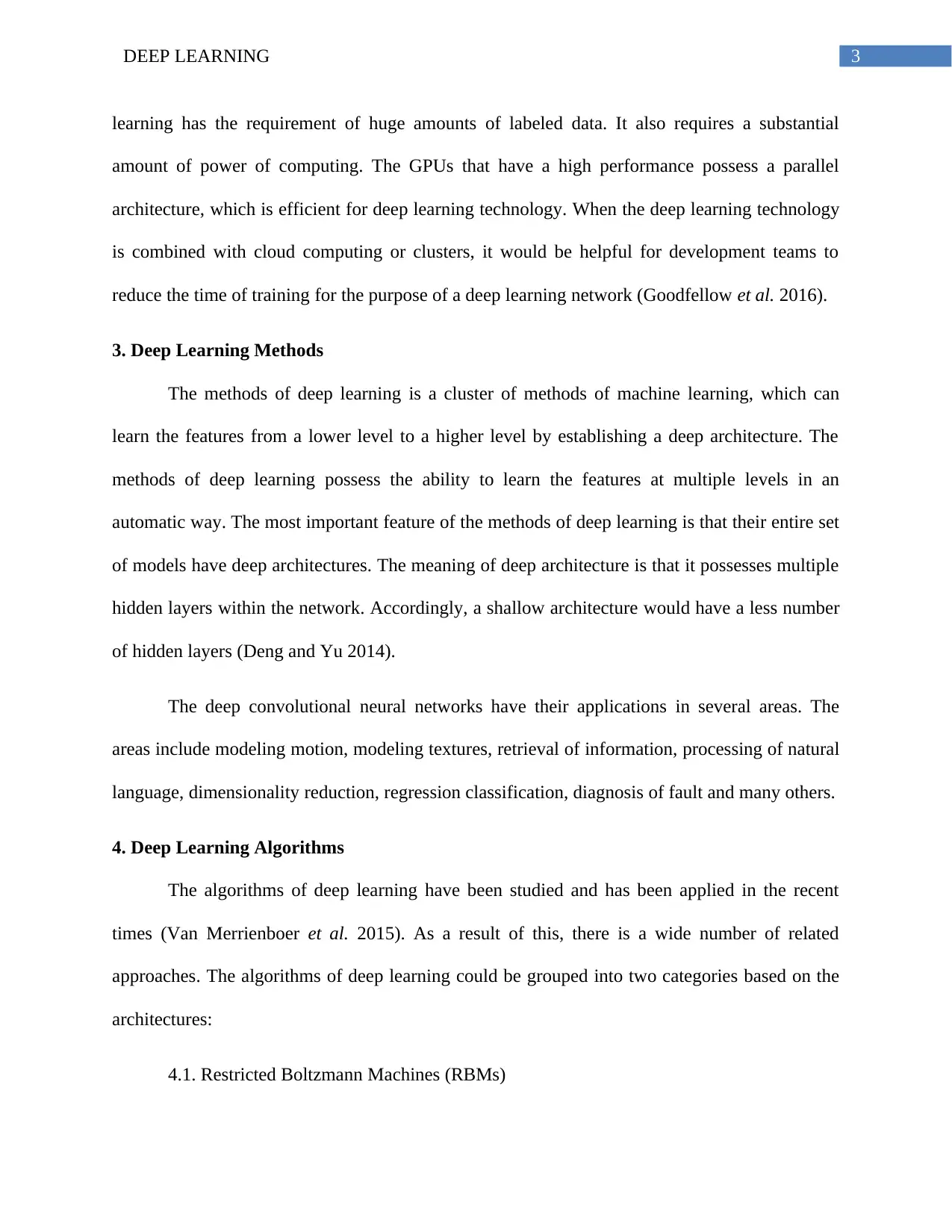
3DEEP LEARNING
learning has the requirement of huge amounts of labeled data. It also requires a substantial
amount of power of computing. The GPUs that have a high performance possess a parallel
architecture, which is efficient for deep learning technology. When the deep learning technology
is combined with cloud computing or clusters, it would be helpful for development teams to
reduce the time of training for the purpose of a deep learning network (Goodfellow et al. 2016).
3. Deep Learning Methods
The methods of deep learning is a cluster of methods of machine learning, which can
learn the features from a lower level to a higher level by establishing a deep architecture. The
methods of deep learning possess the ability to learn the features at multiple levels in an
automatic way. The most important feature of the methods of deep learning is that their entire set
of models have deep architectures. The meaning of deep architecture is that it possesses multiple
hidden layers within the network. Accordingly, a shallow architecture would have a less number
of hidden layers (Deng and Yu 2014).
The deep convolutional neural networks have their applications in several areas. The
areas include modeling motion, modeling textures, retrieval of information, processing of natural
language, dimensionality reduction, regression classification, diagnosis of fault and many others.
4. Deep Learning Algorithms
The algorithms of deep learning have been studied and has been applied in the recent
times (Van Merrienboer et al. 2015). As a result of this, there is a wide number of related
approaches. The algorithms of deep learning could be grouped into two categories based on the
architectures:
4.1. Restricted Boltzmann Machines (RBMs)
learning has the requirement of huge amounts of labeled data. It also requires a substantial
amount of power of computing. The GPUs that have a high performance possess a parallel
architecture, which is efficient for deep learning technology. When the deep learning technology
is combined with cloud computing or clusters, it would be helpful for development teams to
reduce the time of training for the purpose of a deep learning network (Goodfellow et al. 2016).
3. Deep Learning Methods
The methods of deep learning is a cluster of methods of machine learning, which can
learn the features from a lower level to a higher level by establishing a deep architecture. The
methods of deep learning possess the ability to learn the features at multiple levels in an
automatic way. The most important feature of the methods of deep learning is that their entire set
of models have deep architectures. The meaning of deep architecture is that it possesses multiple
hidden layers within the network. Accordingly, a shallow architecture would have a less number
of hidden layers (Deng and Yu 2014).
The deep convolutional neural networks have their applications in several areas. The
areas include modeling motion, modeling textures, retrieval of information, processing of natural
language, dimensionality reduction, regression classification, diagnosis of fault and many others.
4. Deep Learning Algorithms
The algorithms of deep learning have been studied and has been applied in the recent
times (Van Merrienboer et al. 2015). As a result of this, there is a wide number of related
approaches. The algorithms of deep learning could be grouped into two categories based on the
architectures:
4.1. Restricted Boltzmann Machines (RBMs)
Paraphrase This Document
Need a fresh take? Get an instant paraphrase of this document with our AI Paraphraser
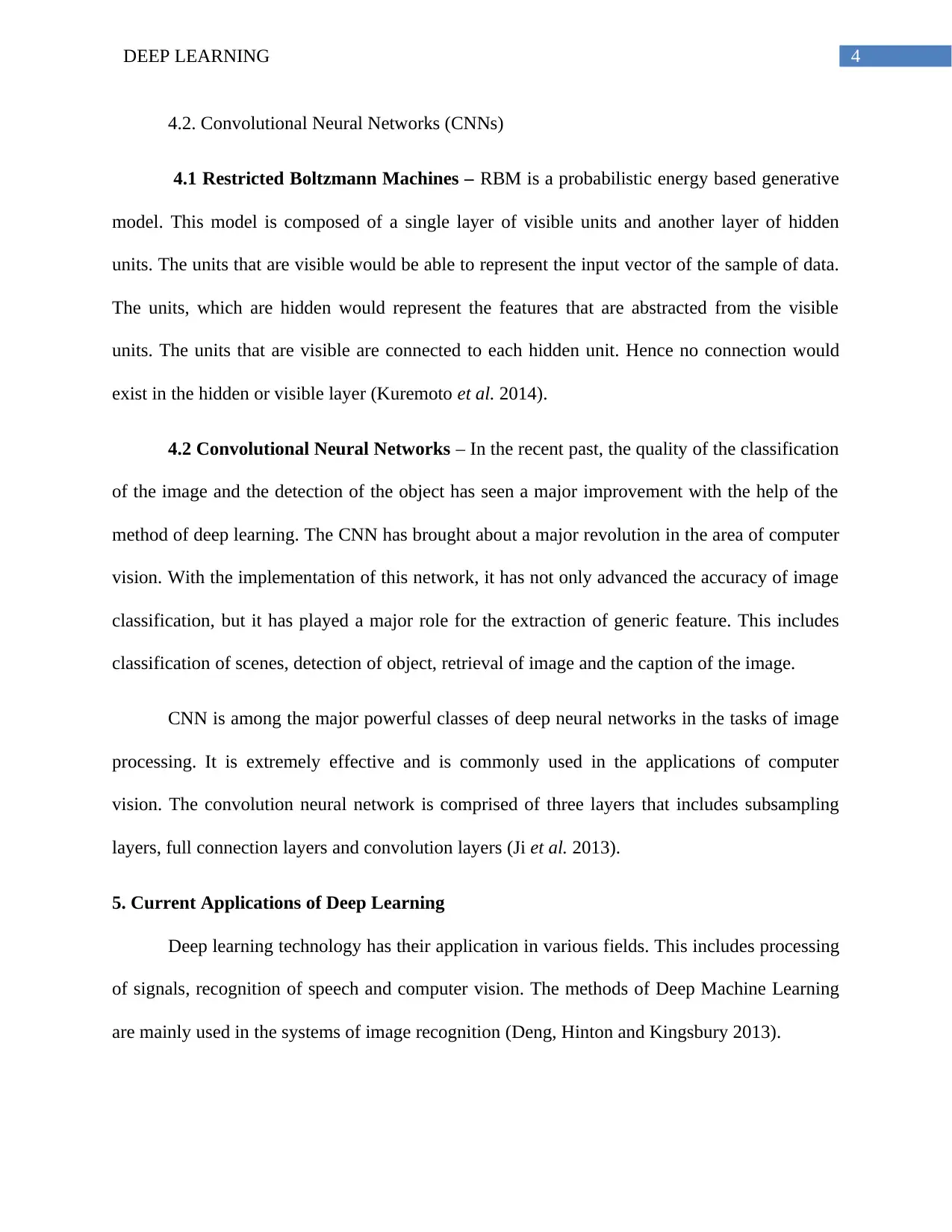
4DEEP LEARNING
4.2. Convolutional Neural Networks (CNNs)
4.1 Restricted Boltzmann Machines – RBM is a probabilistic energy based generative
model. This model is composed of a single layer of visible units and another layer of hidden
units. The units that are visible would be able to represent the input vector of the sample of data.
The units, which are hidden would represent the features that are abstracted from the visible
units. The units that are visible are connected to each hidden unit. Hence no connection would
exist in the hidden or visible layer (Kuremoto et al. 2014).
4.2 Convolutional Neural Networks – In the recent past, the quality of the classification
of the image and the detection of the object has seen a major improvement with the help of the
method of deep learning. The CNN has brought about a major revolution in the area of computer
vision. With the implementation of this network, it has not only advanced the accuracy of image
classification, but it has played a major role for the extraction of generic feature. This includes
classification of scenes, detection of object, retrieval of image and the caption of the image.
CNN is among the major powerful classes of deep neural networks in the tasks of image
processing. It is extremely effective and is commonly used in the applications of computer
vision. The convolution neural network is comprised of three layers that includes subsampling
layers, full connection layers and convolution layers (Ji et al. 2013).
5. Current Applications of Deep Learning
Deep learning technology has their application in various fields. This includes processing
of signals, recognition of speech and computer vision. The methods of Deep Machine Learning
are mainly used in the systems of image recognition (Deng, Hinton and Kingsbury 2013).
4.2. Convolutional Neural Networks (CNNs)
4.1 Restricted Boltzmann Machines – RBM is a probabilistic energy based generative
model. This model is composed of a single layer of visible units and another layer of hidden
units. The units that are visible would be able to represent the input vector of the sample of data.
The units, which are hidden would represent the features that are abstracted from the visible
units. The units that are visible are connected to each hidden unit. Hence no connection would
exist in the hidden or visible layer (Kuremoto et al. 2014).
4.2 Convolutional Neural Networks – In the recent past, the quality of the classification
of the image and the detection of the object has seen a major improvement with the help of the
method of deep learning. The CNN has brought about a major revolution in the area of computer
vision. With the implementation of this network, it has not only advanced the accuracy of image
classification, but it has played a major role for the extraction of generic feature. This includes
classification of scenes, detection of object, retrieval of image and the caption of the image.
CNN is among the major powerful classes of deep neural networks in the tasks of image
processing. It is extremely effective and is commonly used in the applications of computer
vision. The convolution neural network is comprised of three layers that includes subsampling
layers, full connection layers and convolution layers (Ji et al. 2013).
5. Current Applications of Deep Learning
Deep learning technology has their application in various fields. This includes processing
of signals, recognition of speech and computer vision. The methods of Deep Machine Learning
are mainly used in the systems of image recognition (Deng, Hinton and Kingsbury 2013).
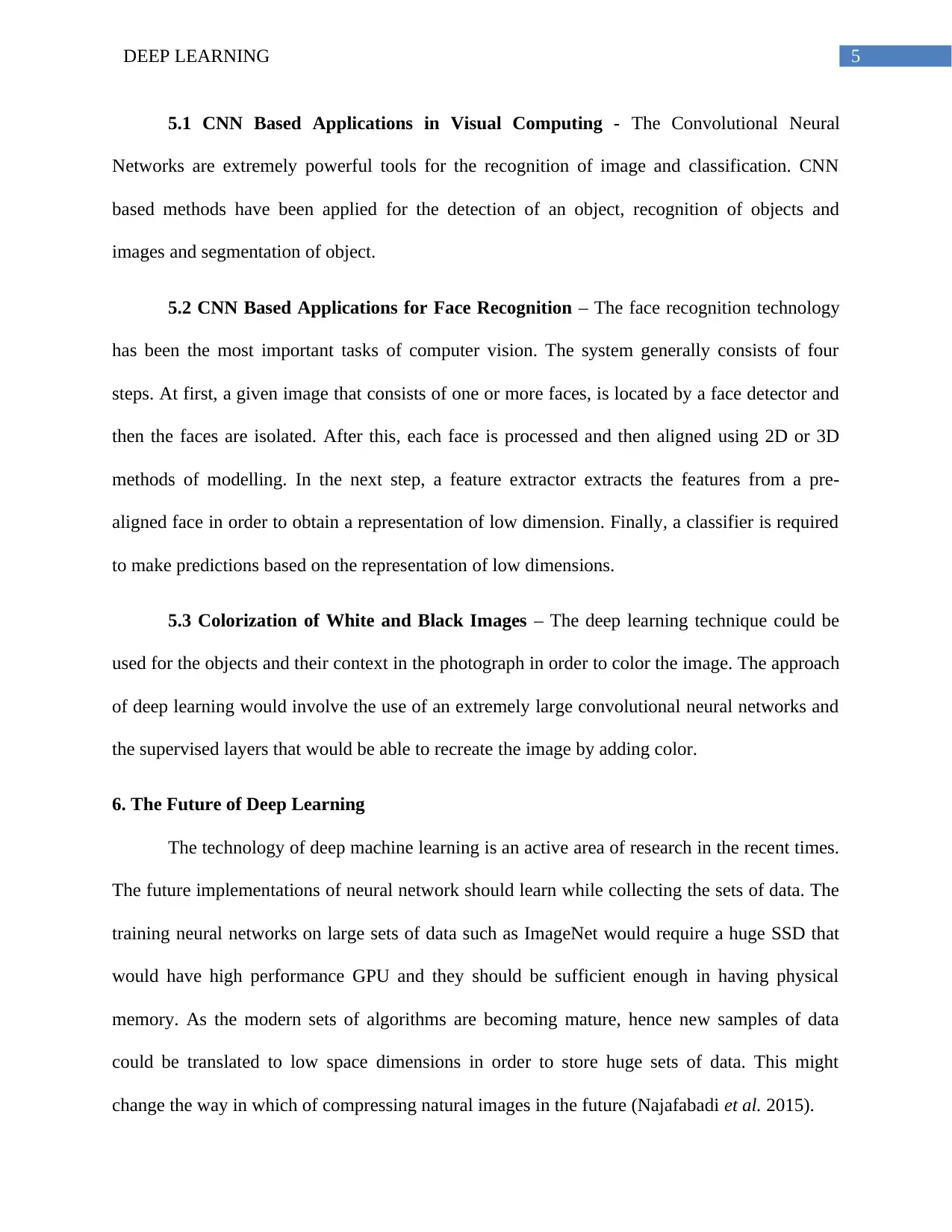
5DEEP LEARNING
5.1 CNN Based Applications in Visual Computing - The Convolutional Neural
Networks are extremely powerful tools for the recognition of image and classification. CNN
based methods have been applied for the detection of an object, recognition of objects and
images and segmentation of object.
5.2 CNN Based Applications for Face Recognition – The face recognition technology
has been the most important tasks of computer vision. The system generally consists of four
steps. At first, a given image that consists of one or more faces, is located by a face detector and
then the faces are isolated. After this, each face is processed and then aligned using 2D or 3D
methods of modelling. In the next step, a feature extractor extracts the features from a pre-
aligned face in order to obtain a representation of low dimension. Finally, a classifier is required
to make predictions based on the representation of low dimensions.
5.3 Colorization of White and Black Images – The deep learning technique could be
used for the objects and their context in the photograph in order to color the image. The approach
of deep learning would involve the use of an extremely large convolutional neural networks and
the supervised layers that would be able to recreate the image by adding color.
6. The Future of Deep Learning
The technology of deep machine learning is an active area of research in the recent times.
The future implementations of neural network should learn while collecting the sets of data. The
training neural networks on large sets of data such as ImageNet would require a huge SSD that
would have high performance GPU and they should be sufficient enough in having physical
memory. As the modern sets of algorithms are becoming mature, hence new samples of data
could be translated to low space dimensions in order to store huge sets of data. This might
change the way in which of compressing natural images in the future (Najafabadi et al. 2015).
5.1 CNN Based Applications in Visual Computing - The Convolutional Neural
Networks are extremely powerful tools for the recognition of image and classification. CNN
based methods have been applied for the detection of an object, recognition of objects and
images and segmentation of object.
5.2 CNN Based Applications for Face Recognition – The face recognition technology
has been the most important tasks of computer vision. The system generally consists of four
steps. At first, a given image that consists of one or more faces, is located by a face detector and
then the faces are isolated. After this, each face is processed and then aligned using 2D or 3D
methods of modelling. In the next step, a feature extractor extracts the features from a pre-
aligned face in order to obtain a representation of low dimension. Finally, a classifier is required
to make predictions based on the representation of low dimensions.
5.3 Colorization of White and Black Images – The deep learning technique could be
used for the objects and their context in the photograph in order to color the image. The approach
of deep learning would involve the use of an extremely large convolutional neural networks and
the supervised layers that would be able to recreate the image by adding color.
6. The Future of Deep Learning
The technology of deep machine learning is an active area of research in the recent times.
The future implementations of neural network should learn while collecting the sets of data. The
training neural networks on large sets of data such as ImageNet would require a huge SSD that
would have high performance GPU and they should be sufficient enough in having physical
memory. As the modern sets of algorithms are becoming mature, hence new samples of data
could be translated to low space dimensions in order to store huge sets of data. This might
change the way in which of compressing natural images in the future (Najafabadi et al. 2015).
⊘ This is a preview!⊘
Do you want full access?
Subscribe today to unlock all pages.

Trusted by 1+ million students worldwide
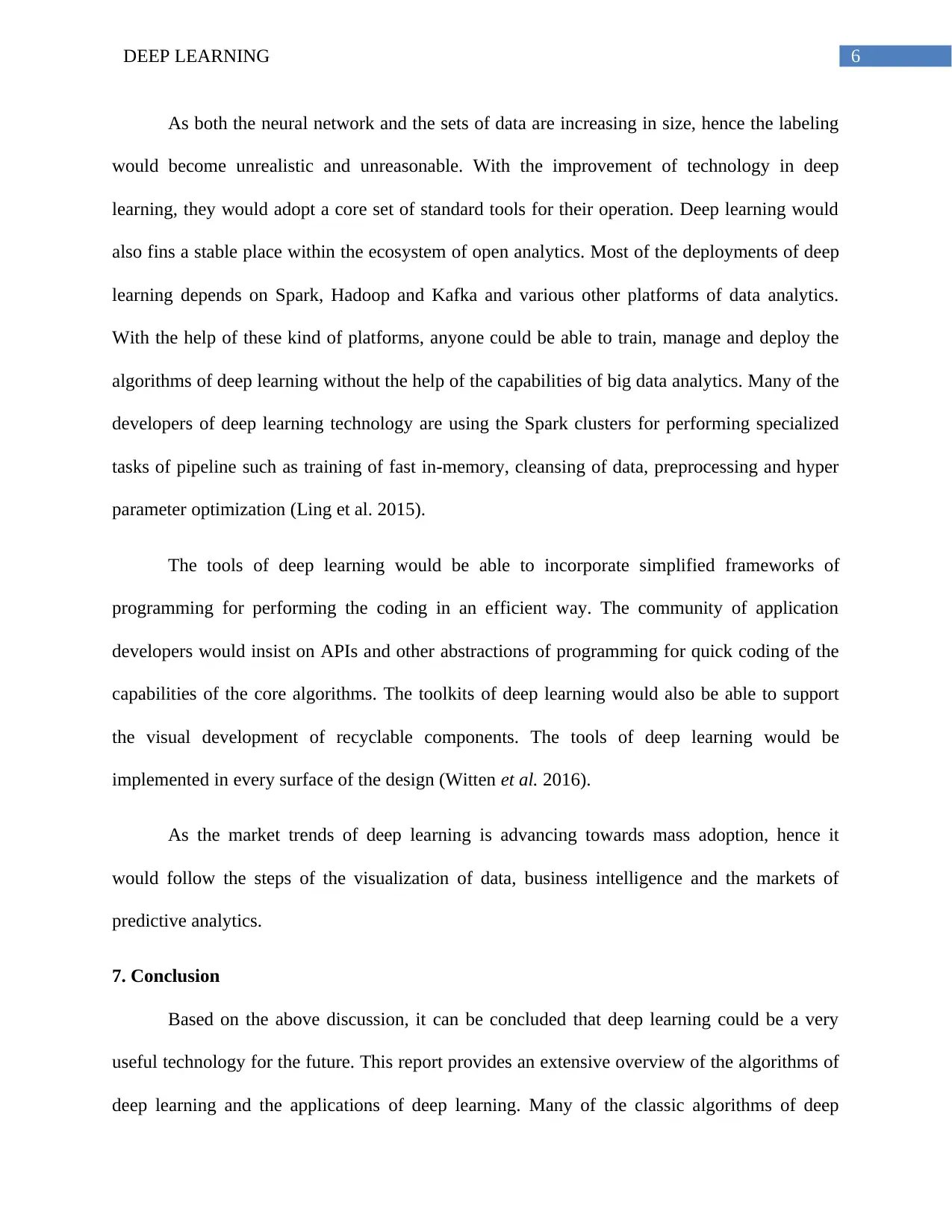
6DEEP LEARNING
As both the neural network and the sets of data are increasing in size, hence the labeling
would become unrealistic and unreasonable. With the improvement of technology in deep
learning, they would adopt a core set of standard tools for their operation. Deep learning would
also fins a stable place within the ecosystem of open analytics. Most of the deployments of deep
learning depends on Spark, Hadoop and Kafka and various other platforms of data analytics.
With the help of these kind of platforms, anyone could be able to train, manage and deploy the
algorithms of deep learning without the help of the capabilities of big data analytics. Many of the
developers of deep learning technology are using the Spark clusters for performing specialized
tasks of pipeline such as training of fast in-memory, cleansing of data, preprocessing and hyper
parameter optimization (Ling et al. 2015).
The tools of deep learning would be able to incorporate simplified frameworks of
programming for performing the coding in an efficient way. The community of application
developers would insist on APIs and other abstractions of programming for quick coding of the
capabilities of the core algorithms. The toolkits of deep learning would also be able to support
the visual development of recyclable components. The tools of deep learning would be
implemented in every surface of the design (Witten et al. 2016).
As the market trends of deep learning is advancing towards mass adoption, hence it
would follow the steps of the visualization of data, business intelligence and the markets of
predictive analytics.
7. Conclusion
Based on the above discussion, it can be concluded that deep learning could be a very
useful technology for the future. This report provides an extensive overview of the algorithms of
deep learning and the applications of deep learning. Many of the classic algorithms of deep
As both the neural network and the sets of data are increasing in size, hence the labeling
would become unrealistic and unreasonable. With the improvement of technology in deep
learning, they would adopt a core set of standard tools for their operation. Deep learning would
also fins a stable place within the ecosystem of open analytics. Most of the deployments of deep
learning depends on Spark, Hadoop and Kafka and various other platforms of data analytics.
With the help of these kind of platforms, anyone could be able to train, manage and deploy the
algorithms of deep learning without the help of the capabilities of big data analytics. Many of the
developers of deep learning technology are using the Spark clusters for performing specialized
tasks of pipeline such as training of fast in-memory, cleansing of data, preprocessing and hyper
parameter optimization (Ling et al. 2015).
The tools of deep learning would be able to incorporate simplified frameworks of
programming for performing the coding in an efficient way. The community of application
developers would insist on APIs and other abstractions of programming for quick coding of the
capabilities of the core algorithms. The toolkits of deep learning would also be able to support
the visual development of recyclable components. The tools of deep learning would be
implemented in every surface of the design (Witten et al. 2016).
As the market trends of deep learning is advancing towards mass adoption, hence it
would follow the steps of the visualization of data, business intelligence and the markets of
predictive analytics.
7. Conclusion
Based on the above discussion, it can be concluded that deep learning could be a very
useful technology for the future. This report provides an extensive overview of the algorithms of
deep learning and the applications of deep learning. Many of the classic algorithms of deep
Paraphrase This Document
Need a fresh take? Get an instant paraphrase of this document with our AI Paraphraser

7DEEP LEARNING
learning that includes Boltzmann machines and convolutional neural networks are being
introduced. In addition to the algorithms of deep learning, the applications would be reviewed
and then compared with the other methods of machine learning.
learning that includes Boltzmann machines and convolutional neural networks are being
introduced. In addition to the algorithms of deep learning, the applications would be reviewed
and then compared with the other methods of machine learning.
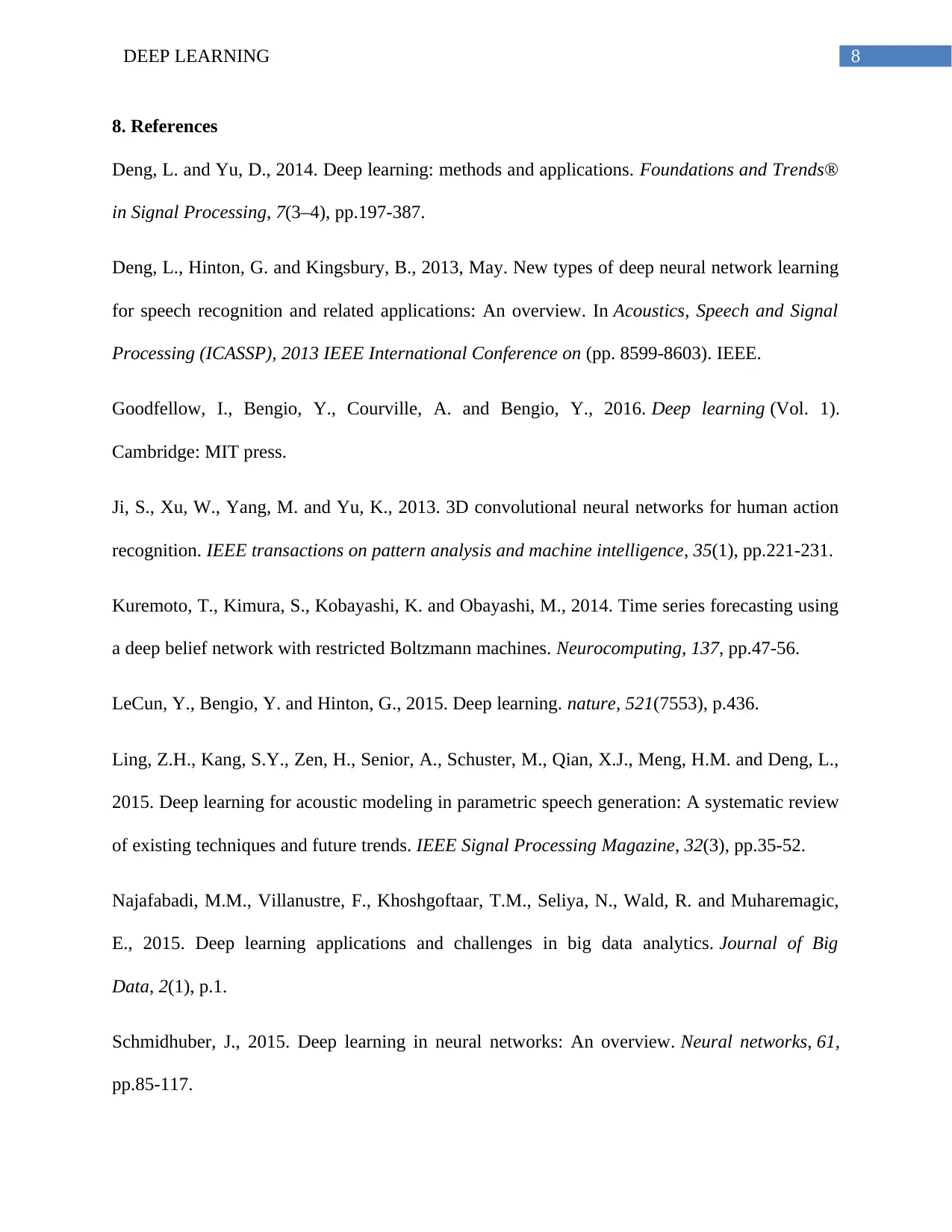
8DEEP LEARNING
8. References
Deng, L. and Yu, D., 2014. Deep learning: methods and applications. Foundations and Trends®
in Signal Processing, 7(3–4), pp.197-387.
Deng, L., Hinton, G. and Kingsbury, B., 2013, May. New types of deep neural network learning
for speech recognition and related applications: An overview. In Acoustics, Speech and Signal
Processing (ICASSP), 2013 IEEE International Conference on (pp. 8599-8603). IEEE.
Goodfellow, I., Bengio, Y., Courville, A. and Bengio, Y., 2016. Deep learning (Vol. 1).
Cambridge: MIT press.
Ji, S., Xu, W., Yang, M. and Yu, K., 2013. 3D convolutional neural networks for human action
recognition. IEEE transactions on pattern analysis and machine intelligence, 35(1), pp.221-231.
Kuremoto, T., Kimura, S., Kobayashi, K. and Obayashi, M., 2014. Time series forecasting using
a deep belief network with restricted Boltzmann machines. Neurocomputing, 137, pp.47-56.
LeCun, Y., Bengio, Y. and Hinton, G., 2015. Deep learning. nature, 521(7553), p.436.
Ling, Z.H., Kang, S.Y., Zen, H., Senior, A., Schuster, M., Qian, X.J., Meng, H.M. and Deng, L.,
2015. Deep learning for acoustic modeling in parametric speech generation: A systematic review
of existing techniques and future trends. IEEE Signal Processing Magazine, 32(3), pp.35-52.
Najafabadi, M.M., Villanustre, F., Khoshgoftaar, T.M., Seliya, N., Wald, R. and Muharemagic,
E., 2015. Deep learning applications and challenges in big data analytics. Journal of Big
Data, 2(1), p.1.
Schmidhuber, J., 2015. Deep learning in neural networks: An overview. Neural networks, 61,
pp.85-117.
8. References
Deng, L. and Yu, D., 2014. Deep learning: methods and applications. Foundations and Trends®
in Signal Processing, 7(3–4), pp.197-387.
Deng, L., Hinton, G. and Kingsbury, B., 2013, May. New types of deep neural network learning
for speech recognition and related applications: An overview. In Acoustics, Speech and Signal
Processing (ICASSP), 2013 IEEE International Conference on (pp. 8599-8603). IEEE.
Goodfellow, I., Bengio, Y., Courville, A. and Bengio, Y., 2016. Deep learning (Vol. 1).
Cambridge: MIT press.
Ji, S., Xu, W., Yang, M. and Yu, K., 2013. 3D convolutional neural networks for human action
recognition. IEEE transactions on pattern analysis and machine intelligence, 35(1), pp.221-231.
Kuremoto, T., Kimura, S., Kobayashi, K. and Obayashi, M., 2014. Time series forecasting using
a deep belief network with restricted Boltzmann machines. Neurocomputing, 137, pp.47-56.
LeCun, Y., Bengio, Y. and Hinton, G., 2015. Deep learning. nature, 521(7553), p.436.
Ling, Z.H., Kang, S.Y., Zen, H., Senior, A., Schuster, M., Qian, X.J., Meng, H.M. and Deng, L.,
2015. Deep learning for acoustic modeling in parametric speech generation: A systematic review
of existing techniques and future trends. IEEE Signal Processing Magazine, 32(3), pp.35-52.
Najafabadi, M.M., Villanustre, F., Khoshgoftaar, T.M., Seliya, N., Wald, R. and Muharemagic,
E., 2015. Deep learning applications and challenges in big data analytics. Journal of Big
Data, 2(1), p.1.
Schmidhuber, J., 2015. Deep learning in neural networks: An overview. Neural networks, 61,
pp.85-117.
⊘ This is a preview!⊘
Do you want full access?
Subscribe today to unlock all pages.

Trusted by 1+ million students worldwide
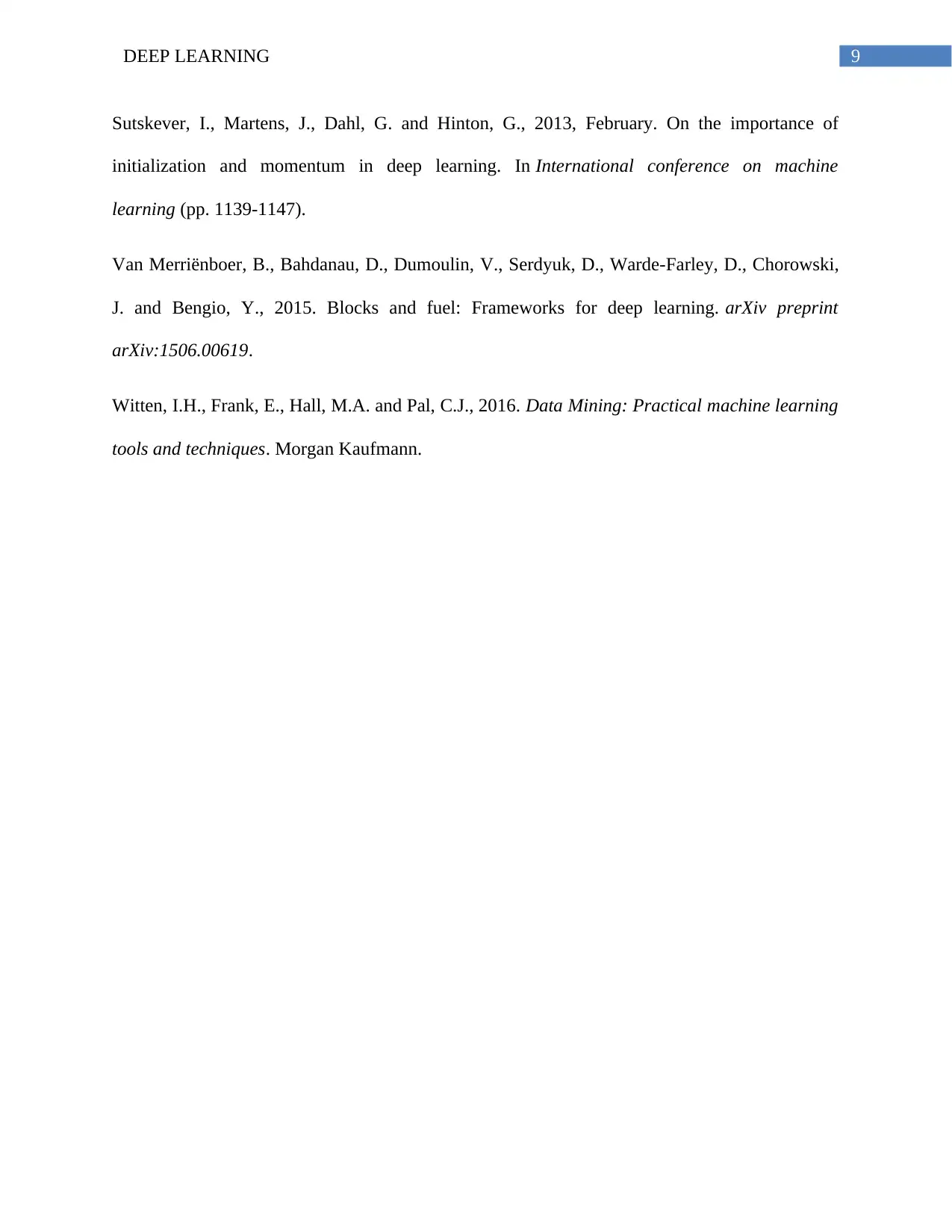
9DEEP LEARNING
Sutskever, I., Martens, J., Dahl, G. and Hinton, G., 2013, February. On the importance of
initialization and momentum in deep learning. In International conference on machine
learning (pp. 1139-1147).
Van Merriënboer, B., Bahdanau, D., Dumoulin, V., Serdyuk, D., Warde-Farley, D., Chorowski,
J. and Bengio, Y., 2015. Blocks and fuel: Frameworks for deep learning. arXiv preprint
arXiv:1506.00619.
Witten, I.H., Frank, E., Hall, M.A. and Pal, C.J., 2016. Data Mining: Practical machine learning
tools and techniques. Morgan Kaufmann.
Sutskever, I., Martens, J., Dahl, G. and Hinton, G., 2013, February. On the importance of
initialization and momentum in deep learning. In International conference on machine
learning (pp. 1139-1147).
Van Merriënboer, B., Bahdanau, D., Dumoulin, V., Serdyuk, D., Warde-Farley, D., Chorowski,
J. and Bengio, Y., 2015. Blocks and fuel: Frameworks for deep learning. arXiv preprint
arXiv:1506.00619.
Witten, I.H., Frank, E., Hall, M.A. and Pal, C.J., 2016. Data Mining: Practical machine learning
tools and techniques. Morgan Kaufmann.
1 out of 10
Related Documents
Your All-in-One AI-Powered Toolkit for Academic Success.
+13062052269
info@desklib.com
Available 24*7 on WhatsApp / Email
![[object Object]](/_next/static/media/star-bottom.7253800d.svg)
Unlock your academic potential
Copyright © 2020–2025 A2Z Services. All Rights Reserved. Developed and managed by ZUCOL.





